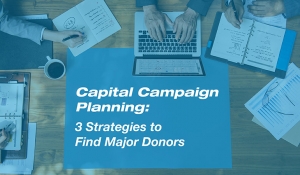 Nonprofits are able to serve their communities because of every single donor that supports their mission through volunteering, advocacy, and gifts of all shapes and sizes. Each supporter deserves appreciation for what they bring to the table.
Nonprofits are able to serve their communities because of every single donor that supports their mission through volunteering, advocacy, and gifts of all shapes and sizes. Each supporter deserves appreciation for what they bring to the table.
When it comes time to plan a large capital campaign, though, it’s time to focus on those constituents who can make or break such a significant undertaking: major donors.
Major donors are the lifeblood of a capital campaign, so they’re important to identify and solicit. But it’s not always so easy to know who has both the ability and propensity to donate to your nonprofit, much less one specific campaign. 1
To help you out, we’ve gathered the top three techniques capital campaign fundraisers need to follow to find their next major donors:
- Look within your donor database.
- Explore business connections.
- Organize in-person events.
It’s easy to feel overwhelmed with the prospect of soliciting major donors because there’s a lot riding on those specific donors. Statistically, more than 88% of your funds come from major gifts! 2
With these strategies on your side, you have nothing to worry about. So let’s get started!

1. Look within your donor database.
As all fundraising professionals know, it’s much harder to solicit an entirely new set of donors than to ask existing supporters for another donation. 3
Think about it in terms of finances. You can spend a lot of money on mass marketing to a wide pool of potential donors who might or might not return that investment with a donation. Or you can send significantly fewer, more targeted messages to donors you already support your mission.
As such, the best place to start looking for major donors is within your own donor database.
Of course, you already know some donors who you could reach out to for a major gift: the ones who have donated large gifts before! But to know which of your current donors has the possibility to become a major donor for the first time, you’re going to need the following information:
- Wealth markers: Property ownership, job title, and zip code can all give you an idea of a individual donor’s ability to give a major gift. But wealth isn’t everything — just because someone is wealthy doesn’t mean they want to give significantly to a nonprofit. Be wary of relying too heavily on this one particular data point.
- Philanthropic indicators: Donors who have previously invested significantly in charity, political causes, and publicly traded stocks are more likely to give major gifts to nonprofits than donors who haven’t.
- Hobbies and interests: No two campaigns are the same, and sometimes it takes a specific cause to spark a major gift. The more you learn about your donors’ interests, the better chance you have of successfully targeting messages to them asking for a contribution to a campaign they would care about.
- Past involvement with your nonprofit: The donors in your database who have contributed in more than one way, such as volunteering, serving on the board, or participating in alternative fundraising campaigns, are likely invested enough in your mission to support you with a major gift. 4
Not sure how to do this yourself? You can always employ a prospect research firm, fundraising consultant, or software solution to batch screen your donor database automatically or manually. 5

2. Explore business connections.
Once you’ve examined your donor database for major donors, it’s time to look beyond the constituents who have supported your nonprofit in the past. You need a prospect list, either one you drew up yourself in-house or one you contracted from a prospect research firm.
But looking beyond your current donors doesn’t mean you should leave them entirely out of mind. On the contrary, your existing donors are your best connection to prospective donors outside your organization.
Put yourself in your prospect’s shoes. You’re a C-level employee at a large corporation. You’ve held seats on various nonprofit boards and regularly post articles about charitable causes on your social media profiles.
You don’t have the time or inclination to respond to an email inbox full of generic solicitations from every nonprofit you’ve never heard of. But what if an old coworker called you to invite you to their favorite charity’s New Year’s gala? Wouldn’t you be much more likely to respond to someone you know?
Ask your current donors to leverage their professional relationships with the individuals who made your prospect list. 6
Business relationships are also important beyond the connections they build to potential donors. You should check your donor database for supporters with the following business connections, which can pay off during your capital campaign:
- Donors who work for companies with corporate philanthropy programs can turn their contribution into a major gift through their employer.
- Executives can influence their company’s corporate philanthropy program, which includes sponsorships and in-kind donations.
- Business owners, especially small business owners, can always benefit from the positive publicity of a partnership with a charitable organization.
- Recently promoted employees will likely have more to give now than they did before.
These types of business data points might not currently exist as fields in your donor prospect profile. But if you’re about to take on a major capital campaign, then you need to know more about these areas than a generic profile might reveal. 7
Modify your prospect template if you’re performing prospect research in-house, and specify what exactly you’re looking for if you’re outsourcing to a prospect research firm or fundraising consultant.

3. Organize in-person events.
The personal touch is everything with major donors. 8 No one will contribute a major gift without really feeling like that donation is not just necessary but appreciated and meaningful.
Before you launch a capital campaign, get personal with your potential major donors by hosting an event.
When nonprofits think of events, often they think of charity auctions or group volunteer events. That’s not what we’re talking about here. We mean events during which donations are not actively collected.
The primary benefit of these events is the chance you get to talk to your most important donors and prospects, to learn more about them and what they care about — and, of course, to convey what you care about. 9
Having a hard time thinking of examples? Here are a few:
- Lunch-and-learns
- Tours of your office or other facilities
- Cocktail receptions
- Networking lunches or happy hours
- Get-to-know-you sessions with new leadership
- Golf tournaments
- Donor appreciation events
- One-on-one lunches
- Group feedback sessions
The beginning of a capital campaign is a great time to hold more personal events that give you facetime with your donors because there’s nothing more powerful than an in-person solicitation.
You don’t even have to have publicly launched your campaign yet to host one of these events. Many nonprofits use the quiet or planning phase of their capital campaigns to connect with major donors and major gift prospects.
So, who should you invite? Try a guest list made up of:
- Staff, board members, and volunteers who can speak well about your nonprofit
- Current contributors of medium to large gifts
- The most likely candidates from your prospect list
- Constituents with connections to those prospects
- Donors with strong business connections
Always include a “plus one” in your invitation. You never know who could show up that wasn’t on your prospect list will end up contributing a major gift because of what they saw or heard.
An important element of any kind of nonprofit event is the follow-up. Always send a note thanking your donors and prospects for attending, mentioning specific conversations you had or people you introduced them to.
Your follow-up is where you include a strong call to action, demonstrating that you were listening to what the attendee had to say and you’ve concluded that they would be an excellent partner in your upcoming campaign. 10
Soliciting major gifts for a capital campaign isn’t an exact science. You will almost always have some of your asks declined, and some of your donors might surprise you with the gifts they’re willing to contribute.
Though you can’t force anyone to donate a certain amount, you can use the strategies at your disposal to show your major gift prospects how great a fit they are for your organization.
To learn more about these topics, check out these additional resources:
- Capstone Advancement Partners: Is Loyalty More Important than Capacity?
- DonorSearch: Major Gifts Guide
- Capstone Advancement Partners: Fundraising is not Rocket Science
- DonorSearch: Nonprofit Crowdfunding Platforms
- Double the Donation: Top 11 Prospect Research Tools
- Capstone Advancement Partners: As Easy as 1, 2, 3
- DonorSearch: Perfect Your Prospect Profile Templates
- Capstone Advancement Partners: Little Things Mean a Lot
- Capstone Advancement Partners: 3 Ways Prospect Research Can Help Nonprofits Raise More Money From Their Current Donors
- MobileCause: Call to Action Examples for Nonprofits (Your Secret Weapon)
About the Author
 Sarah Tedesco is the Executive Vice President of DonorSearch, a prospect research and wealth screening company that focuses on proven philanthropy. Sarah is responsible for managing the production and customer support department concerning client contract fulfillment, increasing retention rate and customer satisfaction. She collaborates with other team members on a variety of issues including sales, marketing and product development ideas.
Sarah Tedesco is the Executive Vice President of DonorSearch, a prospect research and wealth screening company that focuses on proven philanthropy. Sarah is responsible for managing the production and customer support department concerning client contract fulfillment, increasing retention rate and customer satisfaction. She collaborates with other team members on a variety of issues including sales, marketing and product development ideas.


Add Comment